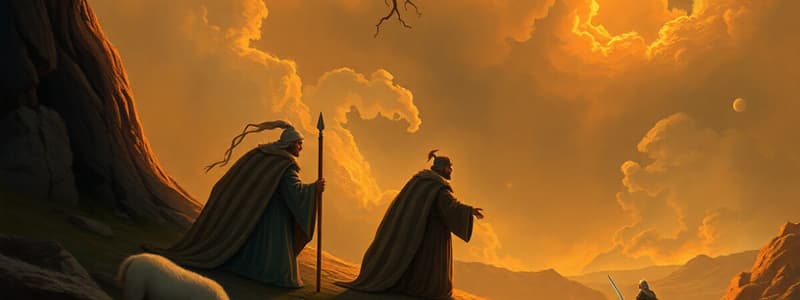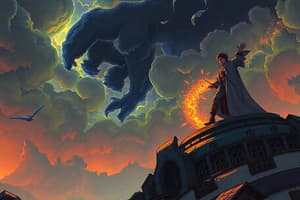Podcast
Questions and Answers
What is the primary purpose of songs of deeds?
What is the primary purpose of songs of deeds?
- To recount the exploits of medieval heroes (correct)
- To teach lessons about morality
- To promote religious beliefs
- To entertain the audience
What are the three theories about the origins of the songs of deeds?
What are the three theories about the origins of the songs of deeds?
Individualist Theory, Traditionalist Theory, Neotraditionalist Theory
How does the Castilian epic differ from other European epics?
How does the Castilian epic differ from other European epics?
- It ignores individual heroes.
- It relies on a fixed meter.
- It exclusively uses perfect rhyme.
- It is more focused on historical reality. (correct)
Castilian epics have a fixed number of syllables.
Castilian epics have a fixed number of syllables.
The rhyme scheme in Castilian epics is typically based on ______.
The rhyme scheme in Castilian epics is typically based on ______.
Which epic poem influenced the Castilian epic?
Which epic poem influenced the Castilian epic?
¿Cuál es el propósito de los poemas narrativos conocidos como canciones de hechos?
¿Cuál es el propósito de los poemas narrativos conocidos como canciones de hechos?
Las canciones de hechos son narrativas escritas únicamente en idiomas germánicos.
Las canciones de hechos son narrativas escritas únicamente en idiomas germánicos.
¿En qué siglo emergió el épico español según algunas teorías?
¿En qué siglo emergió el épico español según algunas teorías?
¿Cuál de las siguientes teorías sugiere que la composición de una canción de hechos se atribuyó a una sola persona?
¿Cuál de las siguientes teorías sugiere que la composición de una canción de hechos se atribuyó a una sola persona?
¿Qué características diferencian la épica castellana de las alemanas y francesas?
¿Qué características diferencian la épica castellana de las alemanas y francesas?
Las canciones de hechos suelen emplear _______ y _______ como esquema de rima.
Las canciones de hechos suelen emplear _______ y _______ como esquema de rima.
¿Cómo se describe la métrica de las épicas castellanas?
¿Cómo se describe la métrica de las épicas castellanas?
¿Qué figura heroica se menciona en comparación con la épica castellana?
¿Qué figura heroica se menciona en comparación con la épica castellana?
Flashcards
Songs of Deeds
Songs of Deeds
Heroic narratives, recited by troubadours, in verse and Romance languages, recounting medieval heroes' exploits.
Spanish Epic Origins
Spanish Epic Origins
Theories suggest a 11th-century Spanish emergence inspired by French epics, or potentially Arab or Germanic origins.
Individualist Theory
Individualist Theory
A song of deed is created by a single person, often connected to a monastery, commissioned to write the poem.
Traditionalist Theory
Traditionalist Theory
Signup and view all the flashcards
Neotraditionalist Theory
Neotraditionalist Theory
Signup and view all the flashcards
Spanish Epic Realism
Spanish Epic Realism
Signup and view all the flashcards
Irregular Meter
Irregular Meter
Signup and view all the flashcards
Assonance/Monorhyme
Assonance/Monorhyme
Signup and view all the flashcards
Epic Style (Formulas)
Epic Style (Formulas)
Signup and view all the flashcards
Castilian Epic Influence
Castilian Epic Influence
Signup and view all the flashcards
Songs of Deeds
Songs of Deeds
Signup and view all the flashcards
Spanish Epic Origins
Spanish Epic Origins
Signup and view all the flashcards
Individualist Theory
Individualist Theory
Signup and view all the flashcards
Traditionalist Theory
Traditionalist Theory
Signup and view all the flashcards
Neotraditionalist Theory
Neotraditionalist Theory
Signup and view all the flashcards
Spanish Epic Realism
Spanish Epic Realism
Signup and view all the flashcards
Irregular Meter
Irregular Meter
Signup and view all the flashcards
Assonance/Monorhyme
Assonance/Monorhyme
Signup and view all the flashcards
Epic Style (Formulas)
Epic Style (Formulas)
Signup and view all the flashcards
Castilian Epic Tradition
Castilian Epic Tradition
Signup and view all the flashcards
Study Notes
Epic Poetry: Cantares de Gesta
- Epic poems, known as cantares de gesta, recount heroic deeds of medieval figures.
- These poems detail the protagonists' pursuit of honor through perilous acts, aiming for fame and recognition.
- Spanish epic poetry shares similarities with European traditions, particularly French.
- Spanish epics often focus on realistic events and historical figures, contrasting with the fantastical elements of some other forms of epic poetry.
- Specific locations and individuals featured in the "Cantar de Mio Cid" are examples of this realism.
Origins of Spanish Epic Poetry
- Theories on the origins of Spanish epic poetry include:
- Imitation of French epics.
- Origin in Arab or Germanic traditions.
- Development from earlier poems (traditional theory).
- Creation by a single poet (individual theory).
- Adaptation and continuation of earlier poems (neo-traditional theory).
Characteristics of Cantares de Gesta
- Realism/Historicity: Focus on believable historical contexts and individuals.
- Examples in the "Cantar de Mio Cid" demonstrate this characteristic.
- Traditional Storytelling: Epics were retold through different genres like chronicles, romances, and plays.
- Formal Aspects:
- Irregular meter and variable syllable counts (differs from French models).
- Use of assonance (repetition of vowel sounds in the verses).
- Use of formulas and epithets to aid memorization and engagement (example: "Mio Cid, the Champion").
Studying That Suits You
Use AI to generate personalized quizzes and flashcards to suit your learning preferences.




